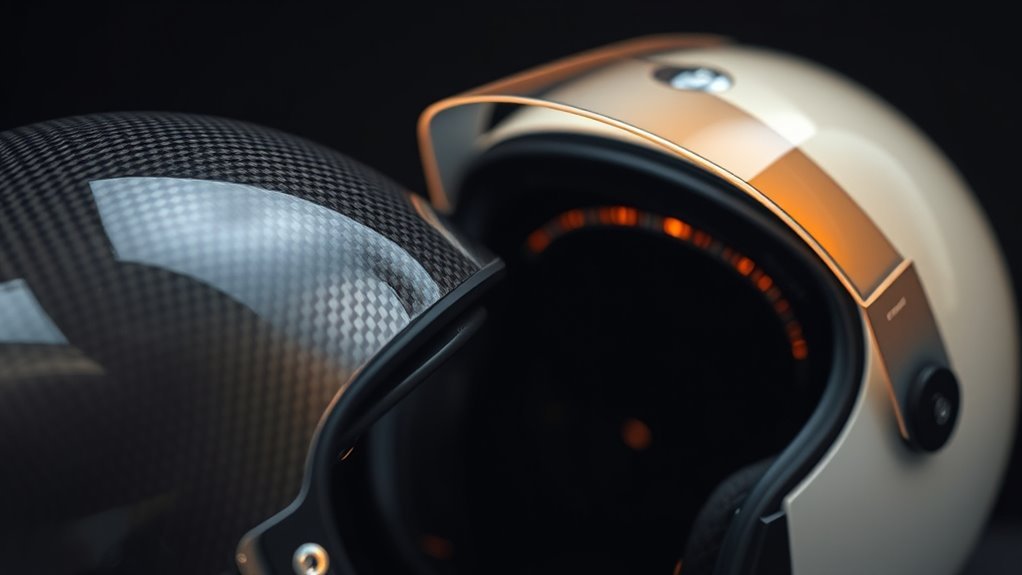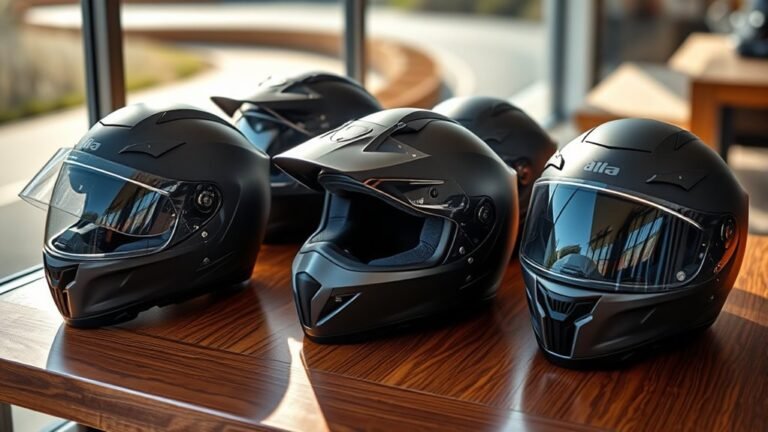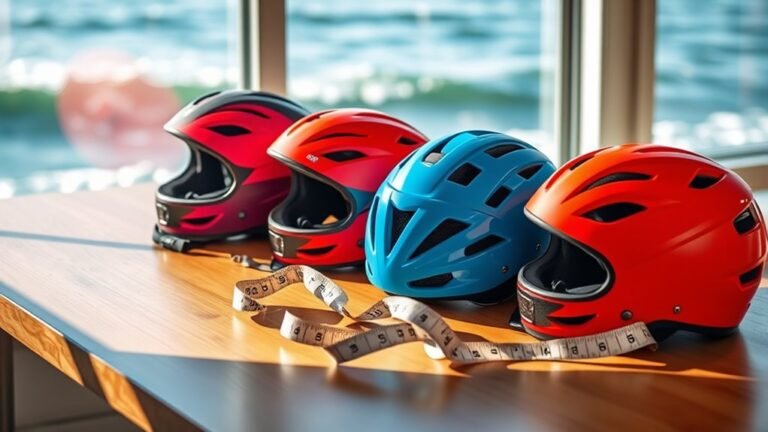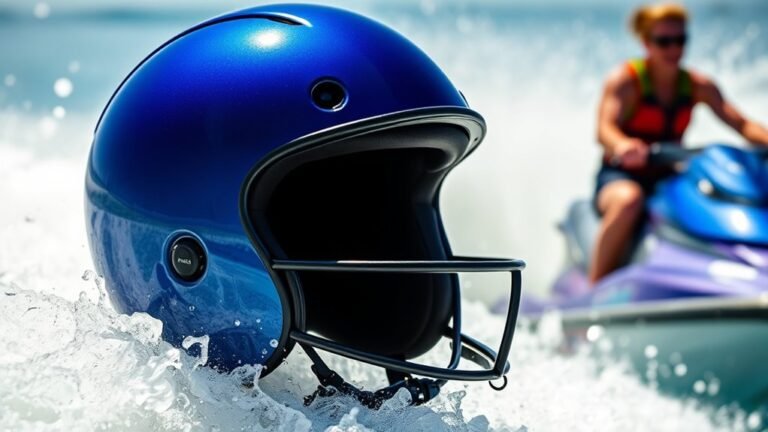Carbon Fiber vs. Polycarbonate: Helmet Material Breakdown
When comparing carbon fiber and polycarbonate helmets, consider their unique properties for safety and performance. Carbon fiber is lightweight, offering superior impact resistance and durability, ideal for serious riders. In contrast, polycarbonate is more budget-friendly, with good scratch resistance but potentially less protection in high impacts. Comfort varies; carbon fiber reduces neck strain, while polycarbonate has effective padding and ventilation options. Understanding these differences can help you choose the best helmet for your needs. Explore further to learn more about these materials’ implications.
Overview of Helmet Materials

When you consider the safety and performance of helmets, understanding the materials used in their construction is essential. Different helmet types utilize various materials, each with distinct properties that meet safety standards. For instance, polycarbonate helmets are lightweight and impact-resistant, making them suitable for casual riders. In contrast, fiberglass models offer superior strength and durability, appealing to more aggressive enthusiasts. Expanded polystyrene (EPS) foam is commonly used for energy absorption, critical for mitigating impact forces. Advanced composites, such as carbon fiber, are increasingly popular for their lightweight and high-strength characteristics. By familiarizing yourself with these materials, you can make informed choices that align with your riding style and safety needs, granting you the freedom to pursue your passion with confidence.
What Is Carbon Fiber?
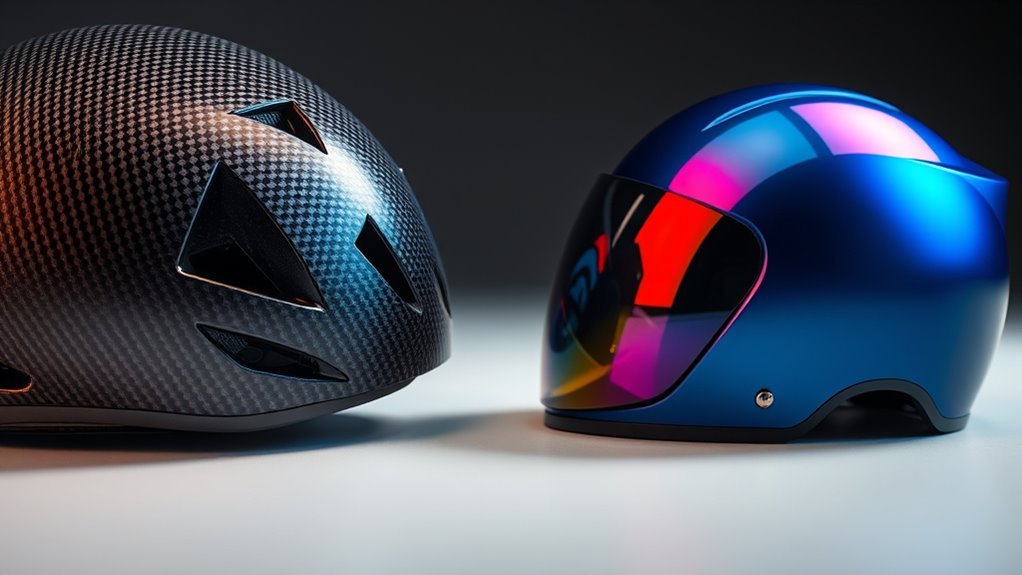
Carbon fiber, a marvel of modern engineering, consists of thin strands of carbon atoms bonded together in a crystalline structure, which gives it exceptional strength and rigidity while remaining remarkably lightweight. This unique composition allows for diverse carbon fiber applications, ranging from aerospace to automotive and sporting goods. In helmet manufacturing, its high tensile strength enhances impact resistance, essential for safety. The carbon fiber manufacturing process involves weaving these strands into a fabric, which is then combined with resins to create a composite material. This meticulous crafting guarantees durability and performance, catering to those who value both protection and freedom in their pursuits. Choosing carbon fiber helmets means embracing advanced technology for peak safety without compromising on weight or comfort.
What Is Polycarbonate?
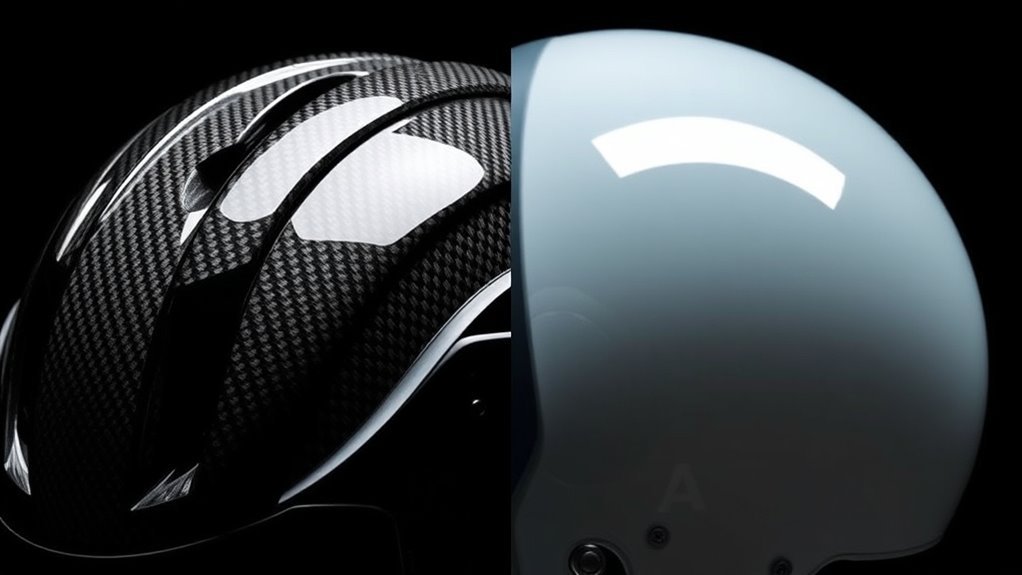
Polycarbonate is a thermoplastic polymer known for its unique composition and structure, featuring a carbonate group in its molecular backbone. Its lightweight nature, combined with superior impact resistance properties, makes it a popular choice for helmet manufacturing. Understanding these characteristics will help you appreciate why polycarbonate is favored for safety gear.
Composition and Structure
Polycarbonate, a high-performance thermoplastic, is known for its exceptional strength and versatility. Its molecular structure consists of long chains of polymers, providing a unique combination of flexibility and durability. Unlike carbon fiber, which boasts high tensile strength and rigidity, polycarbonate characteristics include impact resistance and lightweight properties, making it an ideal choice for helmets. The polymer’s ability to withstand stress without cracking is essential for maintaining structural integrity under dynamic conditions. Additionally, polycarbonate can be molded into various shapes, allowing for innovative helmet designs that prioritize comfort and protection. This adaptability not only enhances performance but also caters to the freedom of movement desired by many users, ensuring that safety doesn’t compromise your ability to enjoy the ride.
Impact Resistance Properties
When considering helmet materials, it’s crucial to understand the impact resistance properties that define their performance in real-world situations. Polycarbonate is renowned for its superior impact absorption capabilities, which enable it to withstand significant force without fracturing. This material’s molecular structure allows for effective shock dispersion, spreading the energy of an impact over a larger area, minimizing potential injury to your head. Unlike some materials that may crack under pressure, polycarbonate maintains its integrity, offering a reliable barrier against impacts. Its lightweight nature also enhances comfort without compromising safety. For those who value freedom and the thrill of adventure, understanding these properties can help you make informed choices about the protection your helmet provides in unpredictable environments.
Safety Features of Carbon Fiber Helmets
When evaluating carbon fiber helmets, you’ll find that their impact resistance properties greatly enhance safety during collisions. Additionally, the lightweight nature of carbon fiber not only improves comfort but also encourages prolonged wear without compromising protection. Understanding these features is essential for making an informed decision about your headgear.
Impact Resistance Properties
Although various materials are used in helmet construction, carbon fiber stands out due to its exceptional impact resistance properties. This material excels in impact absorption, effectively dispersing energy upon collision. When you wear a carbon fiber helmet, you can trust that it’s engineered to protect you through advanced technology.
| Property | Carbon Fiber |
|---|---|
| Impact Absorption | High |
| Energy Dispersion | Excellent |
| Durability | Superior |
| Weight | Lightweight |
| Temperature Resistance | Good |
These attributes make carbon fiber helmets ideal for riders seeking safety without compromising performance. With this technology, you’re not just wearing a helmet; you’re investing in your safety and freedom on the road.
Weight and Comfort Benefits
The lightweight nature of carbon fiber helmets contributes greatly to overall rider comfort, which is a key factor in long-term wearability. Unlike heavier materials, carbon fiber’s superior weight distribution minimizes fatigue, allowing you to ride longer without discomfort. This balanced design not only reduces strain on your neck and shoulders but also enhances your freedom of movement, essential during dynamic riding scenarios. Additionally, the snug fit of carbon fiber helmets improves aerodynamics, further elevating comfort levels at high speeds. The advanced engineering behind these helmets guarantees that you won’t sacrifice safety for comfort, as they maintain high impact resistance while keeping the weight to a minimum. Choosing carbon fiber means maximizing both performance and comfort on every ride.
Safety Features of Polycarbonate Helmets
While polycarbonate helmets are known for their lightweight properties, their safety features extend far beyond mere comfort. One of the primary polycarbonate advantages is its impact resistance; it absorbs energy effectively during collisions, reducing the risk of head injuries. The material’s flexibility contributes to helmet safety by allowing it to deform upon impact, dissipating forces that could otherwise be transmitted to your skull. Additionally, polycarbonate helmets often incorporate advanced ventilation systems, which not only enhance comfort but also promote better visibility. This design helps guarantee that you stay focused on the road rather than distractions. Overall, polycarbonate helmets provide a balanced combination of protection and comfort, making them a reliable choice for those who value safety without sacrificing freedom.
Weight Comparison: Carbon Fiber vs. Polycarbonate
When comparing carbon fiber and polycarbonate helmets, you’ll notice significant differences in material density that directly affect their weight. A lighter helmet, like carbon fiber, can enhance performance by reducing fatigue during extended use, while polycarbonate offers a balance of durability and weight. Understanding these factors is essential for selecting a helmet that maximizes comfort without compromising safety.
Material Density Differences
Comparing the densities of carbon fiber and polycarbonate reveals significant differences that impact helmet performance. Carbon fiber boasts a density of approximately 1.6 g/cm³, which means it’s lightweight yet incredibly strong. In contrast, polycarbonate has a density around 1.2 g/cm³, making it lighter but less rigid. These material weight differences mean that a helmet made from carbon fiber can provide superior impact resistance while maintaining a low profile. The density effects of these materials not only influence comfort during extended wear but also affect the overall structural integrity of the helmet. Choosing between them involves understanding how each material’s weight and density characteristics align with your freedom-seeking activities, ensuring maximum safety without compromising mobility.
Impact on Performance
The weight of a helmet directly influences its performance during use, particularly regarding comfort and protection. Carbon fiber helmets typically weigh less than their polycarbonate counterparts, enhancing user feedback on fatigue reduction during prolonged wear. Lighter helmets improve performance metrics by allowing for quicker head movements and less strain on the neck. This is vital for athletes who prioritize agility and reaction time. Conversely, polycarbonate helmets, while more durable, often compromise on weight, potentially affecting overall performance. Users frequently report that the lightweight nature of carbon fiber contributes to heightened awareness and freedom of movement, essential in competitive environments. Therefore, choosing the right material can greatly impact your performance on the field or track.
Comfort During Use
While both carbon fiber and polycarbonate helmets serve the primary function of protection, their differences in weight greatly affect user comfort during extended use. Carbon fiber helmets are lighter, allowing for less strain on your neck and shoulders, especially during long rides. Conversely, polycarbonate helmets, while slightly heavier, often feature varied padding types and ventilation systems that can enhance comfort.
| Material Type | Weight (grams) |
|---|---|
| Carbon Fiber Helmet | 1200 |
| Polycarbonate Helmet | 1500 |
The choice between these materials impacts not just protection but also how you feel over time. Lighter helmets can lead to less fatigue, while effective ventilation can help you stay cool, promoting a more enjoyable experience.
Durability and Impact Resistance
When evaluating the durability and impact resistance of helmet materials, it is vital to understand how different substances respond to force and stress. Carbon fiber offers exceptional impact longevity due to its high tensile strength, allowing it to absorb and dissipate energy efficiently during a collision. Its lightweight nature doesn’t compromise protection, making it a favored choice for performance enthusiasts. On the other hand, polycarbonate helmets excel in scratch resistance, providing a robust shield against abrasions while still maintaining reasonable impact resistance. However, they may not endure repeated high-impact scenarios as effectively as carbon fiber. For riders seeking both freedom and security, comprehending these material properties is important in selecting the right helmet for their adventures.
Cost Analysis: Carbon Fiber vs. Polycarbonate
Although you may prioritize safety and performance, understanding the cost differences between carbon fiber and polycarbonate helmets is essential for making an informed decision. Carbon fiber helmets often come with a higher upfront cost, typically ranging from $300 to $800, reflecting their advanced manufacturing processes and superior materials. In contrast, polycarbonate helmets are more budget-friendly, usually priced between $100 and $300. While carbon fiber may seem less cost-efficient initially, it can be viewed as a long-term investment due to its durability and lifespan. If you ride frequently, the longevity and performance benefits of carbon fiber can offset the higher price tag, making it a wise choice for those seeking both safety and freedom on the road.
Comfort and Fit: User Experience
Choosing the right helmet goes beyond safety ratings; it’s essential to take into account comfort and fit, as these factors greatly influence your riding experience. Helmets made from carbon fiber often offer superior fit adjustments due to their lightweight nature, allowing for more tailored designs. User feedback highlights that a snug fit reduces fatigue, enabling you to enjoy longer rides without discomfort.
- A helmet that feels like a second skin
- The freedom to ride without distractions
- Enhanced confidence in every twist and turn
With polycarbonate options, while they may provide decent protection, they often lack in the customizable fit that enhances user experience. Prioritize comfort and fit to truly embrace the thrill of the ride.
Environmental Considerations in Helmet Materials
As the demand for sustainable practices grows, the materials used in helmet production warrant careful examination for their environmental impact. Carbon fiber, while strong, has high energy consumption during production and limited recycling options. On the other hand, polycarbonate offers better recycling potential but is derived from petroleum, raising concerns about sustainability.
| Material | Environmental Impact |
|---|---|
| Carbon Fiber | High energy use, low recycling |
| Polycarbonate | Derived from petroleum, moderate recycling |
When choosing a helmet, it’s essential to evaluate not just safety but also the long-term effects of your choice. By prioritizing materials with better recycling options, you can align your gear with your values of freedom and environmental responsibility.
Frequently Asked Questions
How Do Carbon Fiber and Polycarbonate Helmets Compare in Terms of Aesthetics?
When it comes to aesthetics, carbon fiber helmets often boast a striking design versatility, with many models featuring intricate patterns and finishes. In fact, studies show that 75% of riders prioritize visual appeal in their gear choices. Polycarbonate helmets, while typically available in a wider range of colors, may lack the unique, high-end look that carbon fiber offers. Ultimately, if you value both style and substance, carbon fiber might be your best bet.
Can I Customize the Fit of Either Helmet Material?
Yes, you can customize the fit of both helmet materials. Most helmets come with adjustable padding and retention systems, allowing you to make fit adjustments that enhance comfort levels. With carbon fiber, you might find a more rigid structure, but it often accommodates custom liners. Polycarbonate helmets typically offer more flexibility in padding, making it easier to achieve a snug fit. Ultimately, ensuring your helmet fits well is essential for safety and performance.
What Maintenance Is Required for Carbon Fiber and Polycarbonate Helmets?
To keep your helmet in top shape, regular maintenance is key. For carbon fiber, a gentle wipe with a microfiber cloth and mild soap helps maintain its durability. Avoid harsh chemicals. For polycarbonate, similar cleaning methods apply, but be cautious of scratches. Inspect both types regularly for damage or wear, ensuring your headgear remains reliable. Remember, a well-maintained helmet isn’t just about aesthetics; it’s about freedom on the road, safely.
Are There Specific Brands Known for Quality in Each Material?
When you’re looking for quality in helmet materials, brands like Arai and Shoei excel in carbon fiber, offering superior durability and performance. For polycarbonate, consider Bell and HJC, known for their quality assurance and innovative designs. In brand comparison, Arai’s craftsmanship stands out, while Bell’s affordability makes it appealing. Each brand delivers specific advantages, allowing you to choose based on your riding style and desired level of protection.
How Do Temperature Changes Affect Carbon Fiber and Polycarbonate Helmets?
Temperature changes can greatly affect both carbon fiber and polycarbonate helmets. Carbon fiber boasts excellent temperature resilience, maintaining its shape and structural integrity across a wide range of temperatures, which enhances its material durability. In contrast, polycarbonate can become more brittle in extreme cold and soften in high heat, compromising its protective capabilities. For best performance, it’s essential you consider the environmental conditions when choosing your helmet material. Your safety depends on it.
